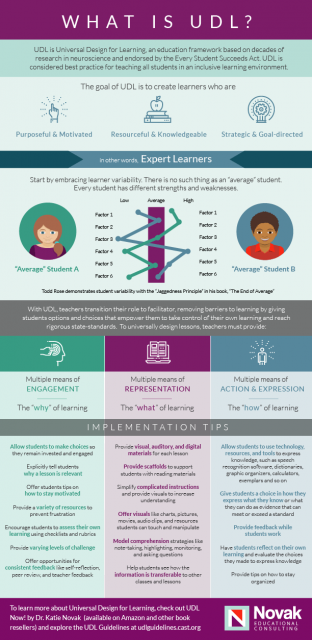With this infographic, Katie Novak, covers the basics of UDL, including the goals and guidelines, and provides some quick-start implementation tips for educators.
What Is UDL? – Infographic
Universal Design for Learning (UDL) is an education framework based on decades of neuroscience research and is endorsed throughout the Every Student Succeeds Act (ESSA). UDL is built on the foundation that all students deserve a rigorous education that allows them to become purposeful & motivated, resourceful & knowledgable, and strategic & goal-directed – in sum, expert learners.
UDL honors student variability, and recognized that it is our systems – not our students – that are disabled. It teaches students how to offer choice and help students take charge of their education by providing multiple means of engagement, multiple means of representation, and multiple means of action and expression. It guides educators to recognize barriers to learning and come up with solutions to remove those barriers for students.
The UDL framework is being adopted by teachers, schools, and districts around the globe and is considered best practice for teaching all students in an inclusive learning environment. UDL empowers both teachers and students by putting students in charge of their own learning.
Yet, many educators have never heard of UDL or have a misunderstanding of what it is. They often think it is the same as Differentiated Instruction, or it can’t be implemented when trying to teach standards. They think it isn’t applicable to young children, or math teachers or *fill in the blank*. But UDL, over time, can completely transform teaching practices and students.




